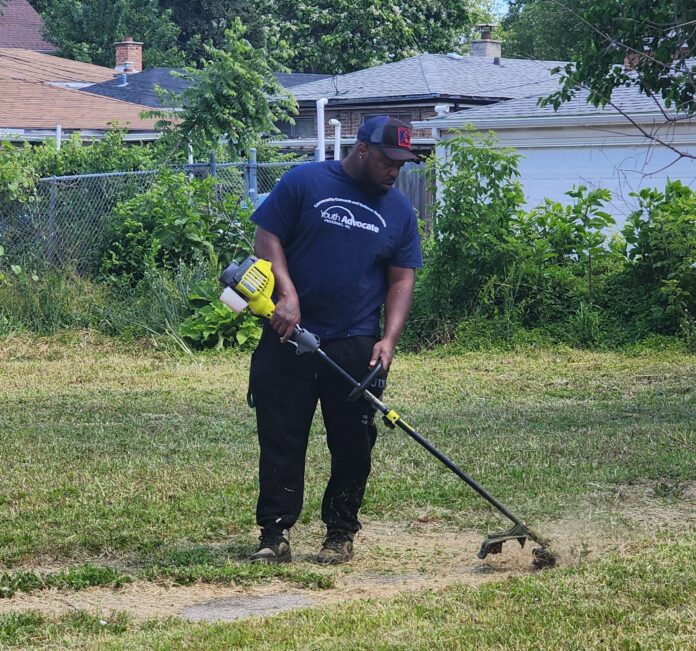Chicago, IL — For John, life after prison has been sweet in many ways.
While incarcerated, he earned his GED and stayed out of trouble, reducing his 11-year attempted murder sentence to nine years plus two in a work release program.
“That day the warden came to my cell and told me I would be starting my work release program, I cried,” John said.
It meant he would move from prison to a halfway house and then be with his family on the weekends.
“I could leave for work Monday through Friday and Friday evenings through Monday mornings, I could be at home with my sister.”
The work release job was at a candy factory, where he was allowed to have all his favorites, including chocolate bars he hadn’t had since he went to prison at age 22. More important, the opportunity gave him valuable experience on the assembly line and training as a forklift operator.
The first-time conviction separated John from his now 15-year-old daughter and his sister and her two children. He said their frequent visits and letters held him down while locked up and that the support he gets from them now is giving him the second chance he needs. John credits Youth Advocate Programs (YAP™), Inc. for providing comprehensive wraparound services to him and his family to aid in the transition.
In its pre-50th anniversary year, YAP delivers community-based services as alternatives to incarcerating or placing young people in detention or other residential justice, child welfare, and behavioral health facilities. In recent years, YAP has used its community-based model as part of services to reduce violence among individuals like John — those identified as being at the highest risk of engaging in violence.
“People released from prison are among those at the highest risk of quickly falling back into the life that got them there,” said YAP Washington Heights Violence Interruption Program Director Ken Lewis. “It takes a lot to help them get used to being back in society.”

John was still completing his work release requirements when he learned about the YAP Washington Heights Violence Interruption program from one of its program coordinators, Deonte Dixon, who also worked at his halfway house. A part-time factory co-worker who serves as a YAP program coordinator recruited and enrolled him. Funded through a grant from the Chicago Department of Public Health, the program provides violence interruption services, street and hospital outreach, crisis intervention, peace building activities, family engagement, individual wraparound services, and conflict resolution.
In serving program participants, the YAP Washington Heights Violence Interruption program staff apply core principles of YAPWrap™, the national nonprofit’s alternative-to-youth-incarceration evidence-based youth justice model. They help individuals identify their strengths and connect them and their families with individualized economic, educational, and emotional tools they need to nurture them.
Among the team’s tools are service projects like a community garden, where program participants work side-by-side with their neighbors, building relationships and trust, while making fresh vegetables available to their families.
“Two weeks after being connected to YAP, I was doing a pop-up shop in Brainerd Park where nonprofits came to the neighborhood to promote their services. There was free barbeque, and we gave bookbags and school supplies to the kids,” John said. “I always wanted to give back to my community.”
John said he was touched to see other men like him, those who were formerly incarcerated or otherwise identified as being at the highest risk for violence engagement, bringing joy to their neighbors. He was also in awe of the commitment from Lewis and the other YAP program staff.
“To see that everybody cares for kids, and seeing how Ken operates — how he really gets involved, it was like, dang, I cried that day, too,” he said.
In addition to connecting him with community service opportunities, John’s YAP Violence Interruption staff enrolled John in financial literacy and anger management classes and connected him with opportunities to share his story to inspire young people to learn from his mistakes.
“John is a hard worker who always showed up for the projects,” Lewis said. “In fact, during one of the financial literacy workshops, he followed up with one of the presenters who he has now partnered with to start a landscaping business.”
“With the resources YAP provided and because I had no issues on my home passes and that I passed all my drug tests,” John said, adding, “I was able to fully return home, ending the work release program and the halfway house early,” John said.
John said the sweetest part of being back home is that he’s now able to give back to his family.
“My daughter is doing great. She just graduated from middle school,” he said. “My nephew is doing amazing in school and as an athlete. it feels good to be able to be a support to him.”
John is grateful that the YAP connection has provided opportunities for him to also support other young people, especially those who remind himself of the young man he used to be.
“I was able to share my story with some kids at my old high school, to and talk about my life,” he said. “A lot of them, their dads were locked up. One was a 14-year-old who had constantly been in and out of police custody. He was addicted to drugs, mostly smoking weed. He didn’t want to deal with the pain.”
As part of the service project, John was able to meet regularly with the youth.
“I helped him by telling him my story and showing him that there’s better things he can do with his time; I told him you have people who love you. I came up to the school; talked to his teacher; talked to his grandma; doing things like that, John said. “Now he’s on a whole better road. Next year he’ll be a junior. His grades improved and I know I helped him make a change in his life.”
Meantime, John is committed to making the changes necessary to put his life on a positive track, including working part-time and spending several hours a day lining up customers for his landscaping business.
“We have 20 contracts to cut people’s grass and we’ll be working on getting business for snow removal in the winter,” he said.
Lewis said about 60 percent of the high-risk individuals he and his team recruit for services stay in the program. Of those who accept services, most are employed or enrolled in educational and vocational programs after completing the YAP Washington Heights Violence Interruption program.
Learn more about YAP and how you can support the nonprofit’s work at www.YAPInc.org.



















